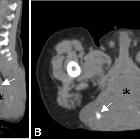heterotopes Hirngewebe

Brain ectopic
tissue in sacrococcygeal region of a child, clinically mimicking sacrococcygeal teratoma: a case report. Sagittal (a) and axial (b) unenhanced CT scan through the lower abdomen and pelvic region demonstrating a (10 × 8 × 4 cm) complex mass lesion with solid (black asterisk) and cystic (white asterisk) components as well as specks of calcification (white arrow) arising from the sacro-coccygeal region extending intra-abdominally to the level of L2 vertebral body. This mass lesion is resulting in compression of the urinary bladder (black arrow) toward the anterior abdominal wall. The imaging features are suggestive of sacro-coccygeal teratoma type III

Ectopic
cerebellar tissue in the occipital bone: a case report. Non-contrast computed tomography via a bone window reveals an oval bone defect in the right occipital bone (a, arrow), and features shown by magnetic resonance imaging using constructive interference in steady state axial sequences (b, c, d, e, arrowheads)

